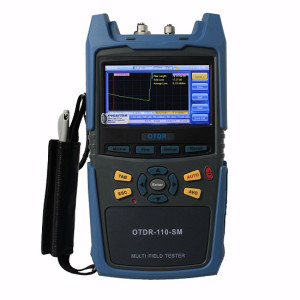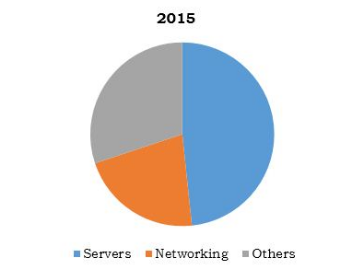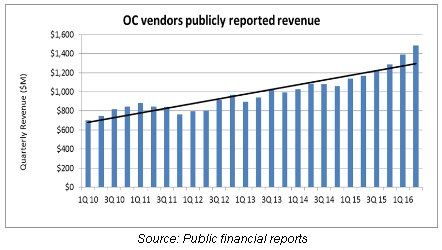 It’s easy to be streaming a demo video in the middle of a teleconference with an important customer and NOT think about how this is actually happening. But if you are at all involved in structured cabling or network management, or share responsibility for these things from a facilities perspective, then you DO think about it. You know, for instance, that in recent years Ethernet speeds and bandwidth have increased by yet another order of magnitude. You also know higher speeds are the result of technological refinements that increase various interactions in the physical and data layers of a cable link over shorter periods of time in the same amount of space.
It’s easy to be streaming a demo video in the middle of a teleconference with an important customer and NOT think about how this is actually happening. But if you are at all involved in structured cabling or network management, or share responsibility for these things from a facilities perspective, then you DO think about it. You know, for instance, that in recent years Ethernet speeds and bandwidth have increased by yet another order of magnitude. You also know higher speeds are the result of technological refinements that increase various interactions in the physical and data layers of a cable link over shorter periods of time in the same amount of space.
This complex interweave of materials, signal and math is the primary reason devices for testing LAN links have become so sophisticated. The sophistication comes in many forms—type and number of tests, speed, ergonomics, full color touch screen, document-based reporting—and causes devices to fall into a few basic categories. This is important because the cost associated with testing devices varies considerably with their purpose and their capabilities. This in turn suggests an overall strategy for cabling contractors to deploy multiple devices and helps both contractors and facilities managers avoid over- or under-spending in this area. More on that in a moment.
Cable and Network Testing
Let’s take a quick look at the breakdown of testing and devices. One of the simplest cable tests, called wire mapping, sends a signal down the link to see if anything is wrong, broken or missing.
A method called time domain reflectometry measures the speed of the signal and maps the channel topology, precisely locating any of a number of possible faults. Sometimes called OTDR or verifiers, these simple wire mapping devices are the equivalent of a pocket knife and should be hanging from every technician’s belt.
A somewhat more useful foundational cable testing device will be able to detect Power over Ethernet (PoE) and capture any networked phones, cameras or other low-voltage devices in the wire map.
The next step up in verifiers enables the technician to troubleshoot the network by identifying specific faults in both the physical and link layers in a channel. What does this mean? Simply that, in addition to broken or split wires, bad connections or other issues associated with the signal itself, the tester will perform a network discovery that tests the data protocols at each link to make sure all devices on the network are properly identifying one another.
Whether you are installing a new run or troubleshooting a faulty one, someone is going to need to test both the physical and link layers and prove that the network is operating to specifications. That takes us to a considerably higher level of testing, typically called qualification or transmission testing. But before we go there, let’s skip to the top for a moment.
Cable Systems and Network Certification
New builds and component manufacturer warranties typically require cabled systems to be certified. Certification means a pass/fail judgment of network performance based on a battery of tests performed, recorded and reported within a very specific procedural framework set forth by applicable TIA and ISO/IEC standards. This goes beyond the ability to determine whether your network does what you and your customer want it to do. You are proving, guaranteeing, certifying to the rest of the world that your network meets the same standards applied to every other network of that type or class. Moreover, it is not you that is doing the certifying, but rather your sophisticated, impartial, and, yes, expensive testing device. And there it is: the certifying tester itself is a product of global telecommunications standards. To be useful, it must be able to measure specifications well beyond those standards in order to render results within comfortable margins and provide headroom for the future. That’s why, for example, the WireXpert certifier from Softing was designed years ago with a frequency range up to 2,500 MHz—far in excess of the Category 8 cabling standard, which has only just now been approved.
Network Link Qualification
As a practical matter, certification only happens after everything has already been installed, fixed and tested. That leaves a lot of situations short of certification where the testing and reporting capabilities of a certifier could come in handy. That is the space occupied by qualifiers.
Softing’s qualifier, called NetXpert, leans toward the same lab-grade testing technology in a battery-powered handheld device that engineers developed for the WireXpert. Basically, the NetXpert qualifier does all the troubleshooting of cable/network testers with one very important addition: It can verify Gigabit Ethernet operation compliant with the IEEE 802.3ab standard. It does this through bit error rate test (BERT), a form of data transmission testing that sends 10 million bits in 10 seconds (1 Gbit/sec), counts the errors, then issues a PASS/FAIL. While distinct from certification, a BERT pass essentially proves the speed of a cable channel is up to standard.
In this way, LAN links are qualified as part of the installation, troubleshooting and repair procedure. You could think of a qualification pass as a sort of precertification that means whatever you are testing is working up to standards and you can move on. At less than a third of the cost of certifiers, it makes sense for every cabling crew to pack a network qualifier. On the other hand, at about twice the cost of a cable verifier it’s overkill to have everyone using them for routine wire mapping and troubleshooting.
Deploying Testing Devices
One way to understand the hierarchy among testing devices is to consider their deployment. Every cabling contractor location should have at least one certifier under a service contract plus one backup. Every crew needs to have a qualifier available to test the fix. Every technician should be carrying a cable verifier, whether they are part of a cabling contractor crew or a facilities management team.
Typically, cabling contractors will install, repair LANs for organizations even where there is an extensive facilities maintenance presence. But considering the high-performance nature of 10G+ Ethernet, it makes sense for in-house staff to be equipped to perform at least some of the initial wire mapping and troubleshooting activities. Where appropriate, cabling contractors should consider putting foundational tools like cable and network verifiers in their customers’ hands as part of a job or service agreement. It’s a good way to help customers retain control, save money and experience less network problem time. It also makes the contractor’s time and resources on service calls more efficient while giving their customers one less reason to do business with a competitor.
In addition to the WireXpert CAT-8 certifier and the NetXpert qualifier, Softing now offers the CableMaster line of cable and network verifiers to the North American market. (The CableMaster 800 is pictured above.) Don’t overspend and under deploy. Make sure you’re using the right testing device for the right job and that everyone on your team—including your customers—has what they need, when they need it.

